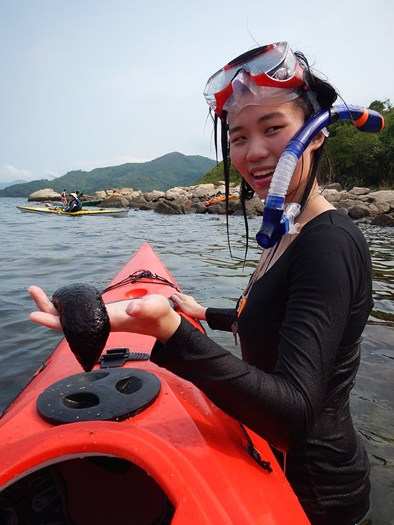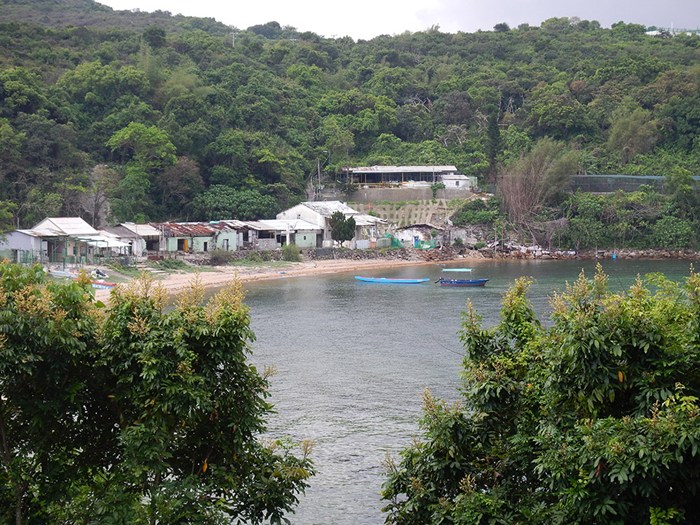HONG KONG - A kaleidoscope of vibrantly hued rhododendron and azalea bushes crawl up through the densely forested emerald hills rising on our left. Palm fronds wave gracefully from the hilltop in the sub-tropical morning breeze. Ma On Shan, called Horse Saddle Mountain by the locals, towers above. This remote windswept ridge, a popular hiking destination in Sai Kung West Country Park, is the second highest peak in Hong Kong’s New Territories. Spirits of long forgotten farmers, fishermen and limekiln workers shimmer on the sultry thermals. Not a highrise in sight. I can almost imagine I’m sea kayaking at home in British Columbia, braving the frigid waters of Howe Sound.
Leaving Long Harbour we paddle westward around the tip of Sai Kung Peninsula into Hoi Ha Wan, which means Bay Beneath the Sea. We beach our kayaks at the base of a rocky freshwater creek. Lacy rivulets trickle down from the hillside creating an intertidal mix of fresh and saltwater, the perfect environment for mangrove trees and crucial nursery grounds for juvenile fish and subtidal invertebrates. While others unwrap sandwiches and claim shoreline spots on the sand, I walk away from the group to escape the relentless sun. I settle in the shade next to a tangle of slender pewter-toned mangrove trunks supporting a canopy of waxy dog-ear sized leaves shining like cucumber skins.
Somewhere in the woods up the hill from the silvery sands, four limekilns, the remains of one of the oldest industries in Hong Kong, lie partially hidden in the undergrowth. From 1800 to 1939 locals fired these kilns to refine lime from oyster shells or coral skeletons for use in construction and agriculture. In 1982, with the help of Hoi Ha villagers, two of these beach stone and crude brick silo-shaped coral burners were restored to their original state creating an historic lunch stop on the hiking trail.
After a quick packed lunch, most of us don masks and snorkels and slip into the tepid shallows through waves lapping up on the silken stretch of fine white sand. Peering down through pristine sparkling water we discover a variegated array of neon-toned hard coral and a rainbow of fish.
We swim lazily, privileged tourists, movements made languid by the tropical waters, where more than 100 years ago industrious villagers armed with long poles rowed out in small boats to break off pieces of the coral that lies beneath us, then harvested their catch with metal tongs attached to bamboo poles and hauled it up the hill to a kiln. Finally, after several what must have been scorching days of tending the white-hot wood fired kiln, they shovelled the fine white dust into sacks. Sweat dripped down their backs as they hefted the scratchy hand-hewn bags on weary shoulders and staggered back down the hill to load the lime onto the decks of waiting junks for transport to Aberdeen on Hong Kong Island. Our guide, Dave, a Brit raised in Tasmania, works as an instructor for Sea Kayak Academy, a division of Outdoor Education Asia.


Above: Paddlers and divers head out to explore Hong Kong's many hidden treasures.
“Swim and float,” Dave says, “but don’t put your feet down and don’t touch. The coral is sharp and fragile.”
We’re lucky to be travelling with an environmentalist with a passion for outdoor education. Not all tourists are so fortunate. The World Wildlife Federation cites the lack of trained guides, along with air pollution from buses and taxis, rubbish left by tourists and insufficient number of washrooms on the hiking trails, as one of the biggest challenges to responsible ecotourism in the area.
Hoi Ha Wan Marine Park, the only one of Hong Kong’s five marine parks with direct road access, offers 230 islands to explore and boasts a dazzling array of coastal and underwater natural resources.
Known for its hard coral and varied species of reef-associated fish, the sheltered bay, situated north of Sai Kung West Country Park on the Sai Kung Peninsula, makes the wilderness of the New Territories northeast of Hong Kong accessible to travellers like me longing for an escape from the city’s hard-edged concrete, steel and glass.
A haven for kayakers and snorkelers, the marine park is a hot spot in the growing ecotourism market. The Hong Kong World Wildlife Federation, formed in 1981, originally concentrated on protection of the Giant Panda and other endangered species. However, in 1988 their focus turned to the establishment of marine parks and reserves. Eventually, in 2003, they created the Hoi Ha Marine Life Centre for marine biodiversity and conservation. Cruises on the shallow-draft glass-bottomed boat Transparency were introduced in an effort to educate and ensure the ecotourism boom was handled in an environmentally responsible manner.
The hour slotted for lunch and snorkel complete, we dip our blades into the waters of the Tolo Channel, not far from Tolo Harbour, once called Mei Zhu, a lake at one time abundant with pearls. Two thousand pearl divers, some living on boats in the sheltered bay their entire lives, regularly braved the depths in this long-ago thriving centre of the pearl industry. Hunting lasted until the Ming Dynasty, when the pearls became nearly extinct.
We glide past the verdant rolling hills of Mo Chau, Moon Island, which along with Ngan Chau, Flat Island, delineate the park boundary. Densely populated Ngan Chau, dubbed Flat Island for its average elevation of 0 metres above sea level, regularly risks severe floods. We paddle mindlessly along its low-lying shoreline, mesmerized by the multi-coloured rocks and sea creatures clearly visible below.
In the distance we catch sight of Port Island, or Chek Chau, meaning red earth. Composed of Danxia, a red-coloured igneous rock rich in iron oxide, this land form is specific to China, Port Island was designated a UNESCO World Heritage Site in 2010. We meander past the barren, red peaks and rusty soil glowing crimson in the eerie silence of the late afternoon sun.
Despite the warm water I shiver as Dave describes mainlanders swimming through waters teeming with sharks to reach the island during the Cultural Revolution in hopes of gaining freedom in Hong Kong.
We roll and toss against choppy waves back past the northern tip of Sai Kung Peninsula. A stiff afternoon breeze blows up as we turn our kayaks southeast and cross Middle Channel toward Tap Mun, Grass Island, for the trip back to base camp. Once in the shelter of the fish farm community anchored along Grass Island’s western shoreline, we lazily meander through a maze of cabins floating on rafts of blue plastic barrels. Overnight campers regularly visit the island’s temple complex dating back to 1788 and restaurants specializing in sun-dried seafood. I’m saddened by the plight of locals no longer able to make a living here in this peaceful place, forced to retreat to the congestion of Hong Kong.
Dave gathers the group. We raft our boats together for a quick safety talk. “Stay close. The corridor we’re crossing has lots of traffic,” he says, just before we make one last dash across the ferry route. At first I think we are on a collision course with a menacing two-tiered ferry and several speedy water taxis, but they easily pull ahead of us.
Suddenly, the tranquil islands we visited earlier seem so far away.
Information
WHERE TO STAY: The Salisbury – YMCA of Hong Kong: 41 Salisbury Rd. (852) 2268-7000.
www.ymcahk.org.hk. Upscale for a YMCA. Newly renovated. / Hong Kong Sky City Marriott Hotel: 1 Sky City Road East, Hong Kong International Airport, Lantau. (852) 3969-1888.
www.marriott.com (search “Hong Kong”) Luxury hotel five minutes from the airport, infinity pool, award-winning spa. / Sea Kayak Academy: (852) 3482-3912.
www.seakayakacademy.com. Tours vary in length. Base camp location also at Tai O, home of the pink dolphins and Tai Long Wan, Big Wave Bay, a popular Hong Kong surf destination. / Aqua Bound Centre: (852) 8211-3876.
www.aquabound.com.hk. A range of classes for children and adults. / To get there, take the MTR to Diamond Hill Station, Exit C2. Take bus 92 or 96R (Sunday and public holidays only) to Sai King Town, then change to green minibus 7 to Hoi Ha Tsuen and walk to the Marine Park.
About the Author
Following rewarding careers as teachers and educational administrators in Vancouver and Richmond, British Columbia, Patti and Barry studied journalism and photography and then set out to pursue adventure travel. Whether canoeing the Yukon River, backcountry skiing in B.Cl’s Monashee Mountains, hiking in Scotland’s Outer Hebrides or trekking in Tibet and Nepal, they embrace the culture and environment of wilderness areas. When not travelling, they ski in the winter – downhill, nordic and backcountry – out of their home base at Silver Star Mountain Resort in the Okanagan Valley and paddle in summer – whitewater, canoeing and kayaking, river and lake tripping and stand up paddle boarding – from their Ontario island cottage.